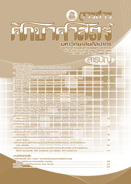ปัจจัยที่ส่งผลต่อพฤติกรรมเอื้อเฟื้อเผื่อแผ่ของนักเรียนระดับชั้นมัธยมศึกษาตอนต้น อำเภอสามพราน จังหวัดนครปฐม
Main Article Content
Abstract
ผลการวิจัยพบว่า
1. กลุ่มตัวอย่างมีพฤติกรรมเอื้อเฟื้อเผื่อแผ่ การส่งเสริมความเอื้อเฟื้อเผื่อแผ่จากครอบครัว การส่งเสริมความเอื้อเฟื้อเผื่อแผ่จากโรงเรียน และการเลียนแบบความเอื้อเฟื้อเผื่อแผ่จากสื่ออยู่ในระดับมาก
2. พฤติกรรมเอื้อเฟื้อเผื่อแผ่ของนักเรียนระดับชั้นมัธยมศึกษาตอนต้น อำเภอสามพราน จังหวัดนครปฐม จำแนกตาม เพศ ลักษณะครอบครัว และผลสัมฤทธิ์ทางการเรียน มีความแตกต่างกันอย่างมีนัยสำคัญทางสถิติที่ระดับ .05 แต่เมื่อจำแนกตามการมีพี่น้องในครอบครัว ความเพียงพอของค่าใช้จ่ายที่ได้รับและประสบการณ์ประทับใจจากการได้รับความเอื้อเฟื้อเผื่อแผ่จากผู้อื่น ไม่พบความแตกต่าง
3. การส่งเสริมความเอื้อเฟื้อเผื่อแผ่จากครอบครัว การเลียนแบบความเอื้อเฟื้อเผื่อแผ่จากสื่อ และการส่งเสริมความเอื้อเฟื้อเผื่อแผ่จากโรงเรียน สามารถร่วมกันทำนายพฤติกรรมเอื้อเฟื้อเผื่อแผ่ของนักเรียนระดับชั้นมัธยมศึกษาตอนต้น ได้ร้อยละ 70 อย่างมีนัยสำคัญทางสถิติที่ระดับ .05
FACTORS AFFECTING ALTRUISTIC BEHAVIOR OF SECONDARY SCHOOL STUDENTS IN SAM PHRAN DISTRICT, NAKHON PATHOM PROVINCE
A The purposes of this research were 1) to study levels of altruistic behavior, altruism promoting from family, altruism promoting from school, and altruism imitation from media of secondary school students in Sam Phran district, Nakhon Pathom province, 2) to compare altruistic behavior of secondary school students in Sam Phran district, Nakhon Pathom province as classified by sex, sibling in family, family characteristics, sufficiency of allowance, impressive experiences stem from receiving altruism from others, and academic achievement, 3) to determine altruism promoting from family, altruism promoting from school, and altruism imitation from media as the predictors of secondary school students’ altruistic behavior. Samples were 348 secondary school (grade 7-9) students in Sam Phran district, Nakhon Pathom province derived by stratified random sampling technique. Instruments used to collect data were questionnaires constructed by the researcher. Data were analyzed for percentage, mean, standard deviation, t - test, one–way ANOVA and the stepwise multiple regression analysis.
The results found that:
1. Secondary school students’ altruistic behavior were at the high level, altruism promoting from family, altruism promoting from school, and altruism imitation from media were at the high level.
2. Secondary school students’ altruistic behavior as classified by sex, family characteristics, academic achievement, were significantly different at a .05 level. Whereas, altruistic behavior as classified by sibling in family, sufficiency of allowance, and impressive experiences stem from receiving altruism from others were not significantly different.
3. Altruism promoting from family, altruism promoting from school, and altruism imitation from media predicted the secondary school students’ altruistic behavior at the percentage of 70, with statistical significance of .05.


